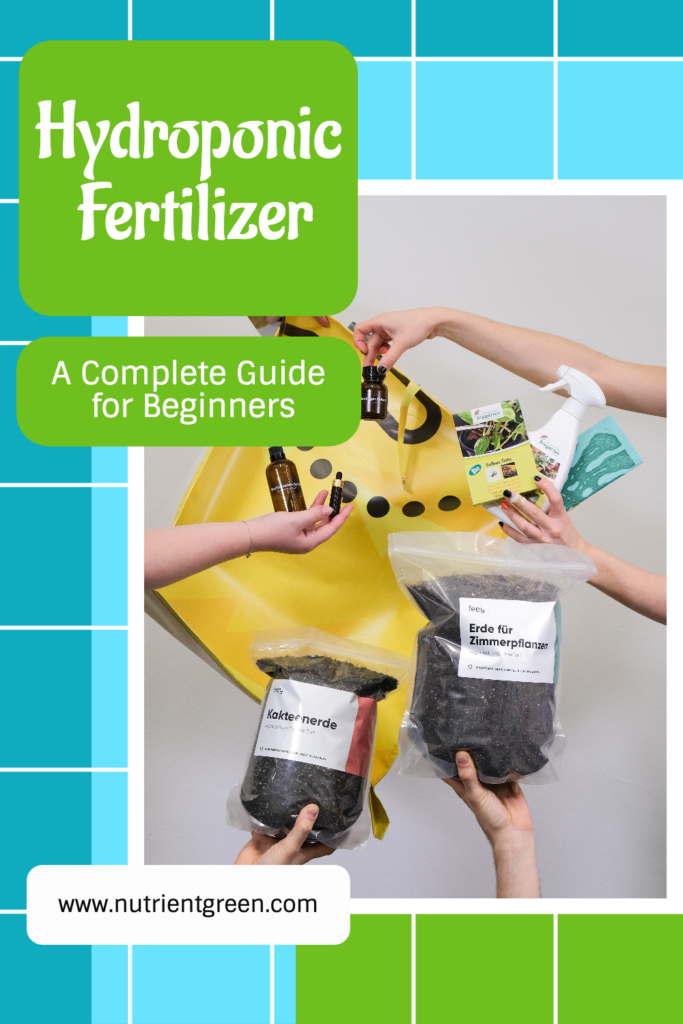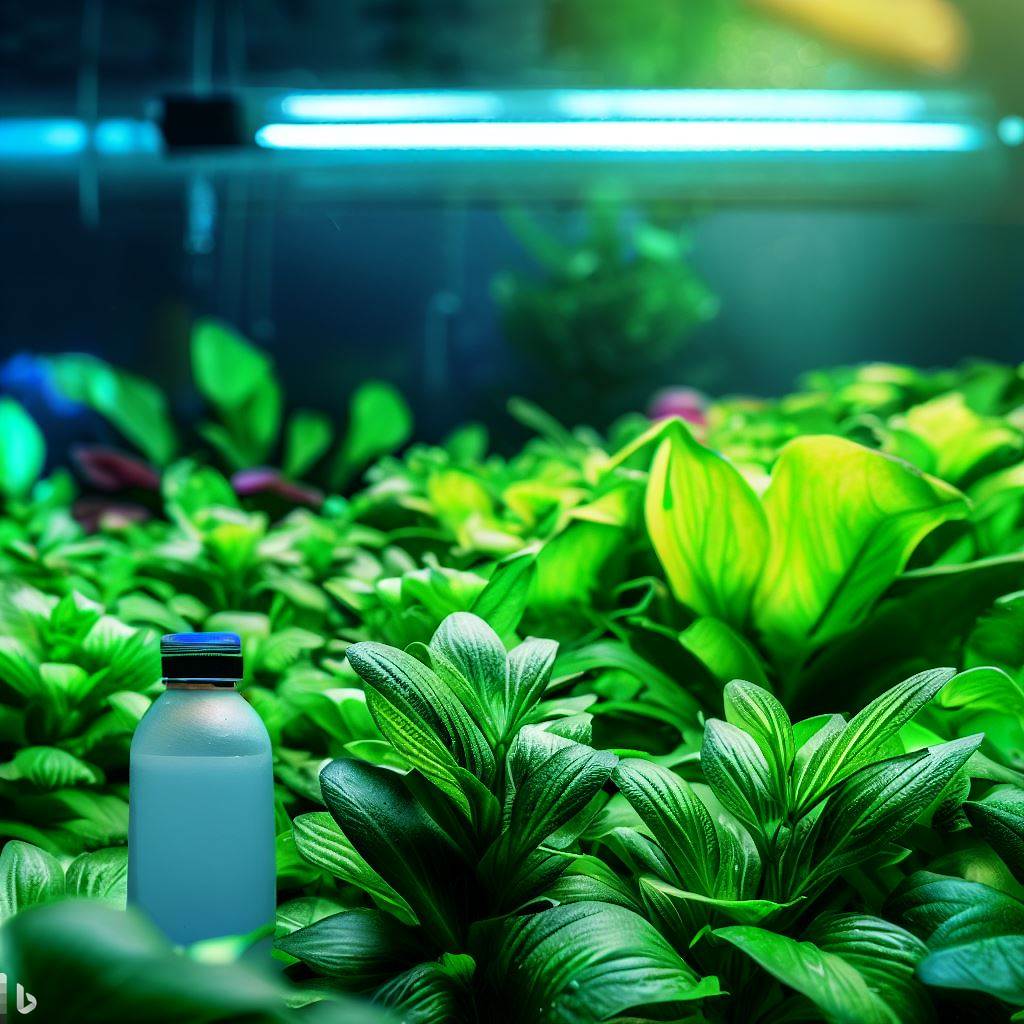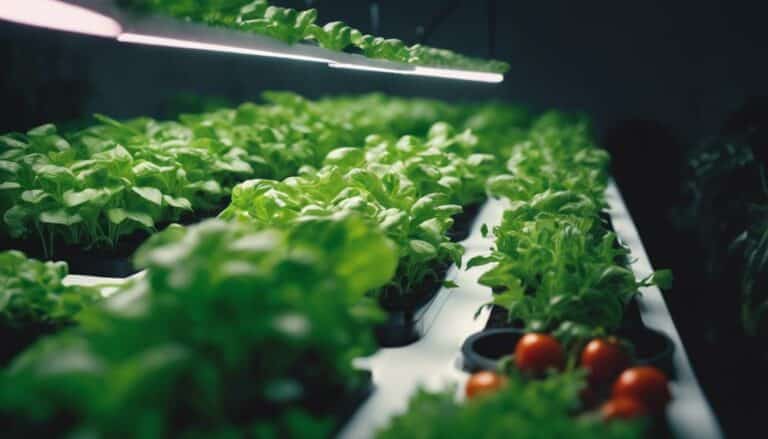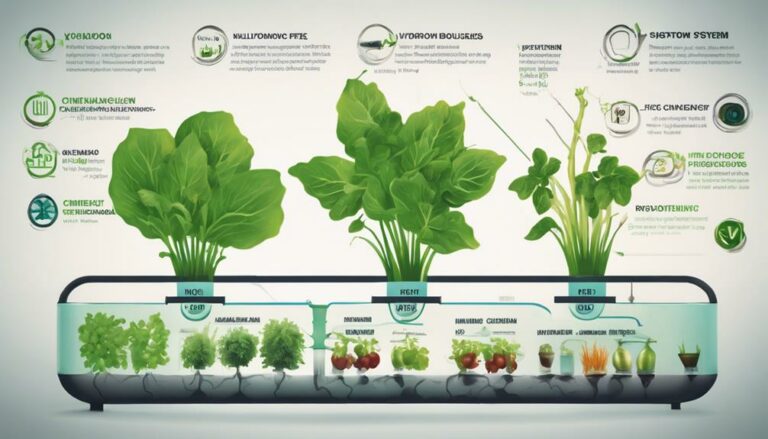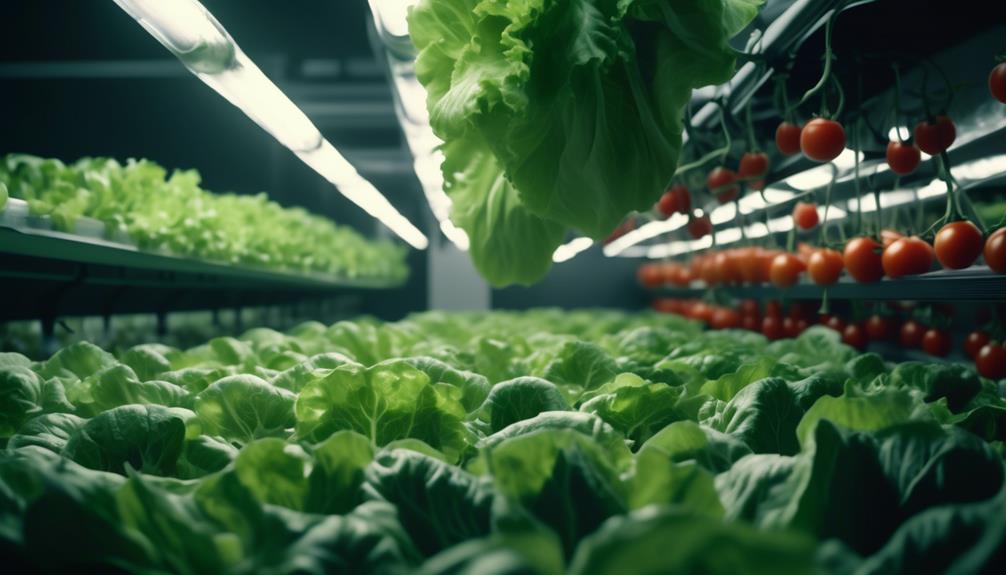Table of Contents
Hydroponic gardening is a method of growing plants without soil, using water-based mineral nutrient solutions instead. This way, you can grow plants in any space, indoors or outdoors, with less water, less waste, and less hassle. But how do you feed your plants without soil? That’s where hydroponic fertilizer comes in.
In this article, we will explain the benefits of hydroponic fertilizer, the different types of hydroponic fertilizer available, how to choose the best one for your plants, how to use it properly, and how to avoid common mistakes. By the end of this article, you will have a better understanding of how to nourish your hydroponic plants and enjoy a bountiful harvest.
Hydroponic fertilizer
Hydroponic gardening has gained immense popularity among gardening enthusiasts in recent years. The method of growing plants without soil, using a nutrient-rich water solution, offers numerous advantages. One crucial aspect of hydroponic gardening is the use of hydroponic fertilizer, which provides essential nutrients to the plants for their optimal growth.
Hydroponic fertilizer is a special type of fertilizer that is designed for hydroponic systems. It provides all the essential nutrients plants need to grow and thrive in water. Unlike soil-based fertilizers, hydroponic fertilizers are water-soluble and easily absorbed by the plant roots. They also have a balanced pH level and do not contain any organic matter that can clog the system or cause diseases.
Importance of Hydroponic Fertilizer
Hydroponic fertilizer plays a vital role in the success of hydroponic gardening. Since plants are not growing in soil, they rely entirely on the nutrients provided through the hydroponic solution. A well-balanced fertilizer ensures that plants receive the right amount of nutrients at each growth stage. It promotes robust root development, healthy foliage, and abundant fruiting or flowering.
Essential Nutrients for Hydroponic Plants
Hydroponic plants require a range of essential nutrients for their optimal growth. These nutrients can be divided into two categories: macronutrients and micronutrients.
- Macronutrients include nitrogen (N), phosphorus (P), potassium (K), calcium (Ca), magnesium (Mg), and sulfur (S).
- Micronutrients, on the other hand, are needed in smaller quantities and include iron (Fe), manganese (Mn), zinc (Zn), copper (Cu), boron (B), molybdenum (Mo), and chlorine (Cl).
Benefits of Hydroponic Fertilizer
Using hydroponic fertilizer has many advantages over using soil-based fertilizers or no fertilizers at all. Here are some of the benefits of hydroponic fertilizer:
- It boosts plant growth and yields. Hydroponic fertilizer delivers the optimal amount and ratio of nutrients that plants need at each stage of their development. This results in faster growth, bigger blooms and more fruits and vegetables.
- It improves plant health and quality. Hydroponic fertilizer prevents nutrient deficiencies and imbalances that can cause stunted growth, yellowing leaves, wilting flowers and poor taste. It also enhances the color, flavor, aroma and nutritional value of your crops.
- It saves water and resources. Hydroponic fertilizer reduces water consumption by up to 90% compared to soil-based gardening. It also eliminates the need for pesticides, herbicides and fungicides that can harm the environment and your health.
- It simplifies maintenance and management. Hydroponic fertilizer makes it easy to control and monitor the nutrient levels in your system. You don’t have to worry about soil pH, soil compaction, soil erosion or soil-borne pests and diseases.
Types of Hydroponic Fertilizer
There are many types of hydroponic fertilizer available on the market today. They vary in their ingredients, forms, functions and prices. Here are some of the most common types of hydroponic fertilizer:
- Organic vs synthetic. Organic fertilizers are made from natural sources such as seaweed, fish emulsion, worm castings and compost tea. They are rich in micronutrients and beneficial microbes that can improve soil health and plant immunity. However, they are not always water-soluble and may require additional processing or filtering before use. Synthetic fertilizers are made from refined minerals or salts that are specially formulated for hydroponics. They are highly water-soluble and readily available for plant uptake. However, they may lack some micronutrients and beneficial microbes that organic fertilizers provide.
- Liquid vs powder. Liquid fertilizers are pre-mixed solutions that are ready to use or dilute with water. They are convenient and easy to apply but may have a shorter shelf life and higher shipping cost than powder fertilizers. Powder fertilizers are dry granules or crystals that need to be dissolved in water before use. They are more economical and have a longer shelf life than liquid fertilizers but may require more accurate measuring and mixing than liquid fertilizers.
- Single-part vs multi-part. Single-part fertilizers are complete formulas that contain all the macro and micronutrients that plants need in one bottle or bag. They are simple and user-friendly but may not be suitable for all plants or stages of growth. Multi-part fertilizers are separate formulas that contain different nutrients that can be mixed together according to your plants’ needs. They are more flexible and customizable but may require more knowledge and skill than single-part fertilizers.
How to Choose the Best Hydroponic Fertilizer
Choosing the best hydroponic fertilizer for your plants depends on several factors such as your plant type, your system type, your budget and your preference. Here are some tips to help you choose the best hydroponic fertilizer:
- Check the N-P-K ratio. The N-P-K ratio stands for nitrogen (N), phosphorus (P) and potassium (K), which are the three primary macronutrients that plants need in large quantities. The N-P-K ratio indicates the percentage of each nutrient in the fertilizer by weight. For example, a 10-10-10 fertilizer contains 10% nitrogen, 10% phosphorus and 10% potassium by weight. Different plants have different N-P-K requirements depending on their growth stage and function. For example, leafy greens need more nitrogen than fruiting crops; flowering crops need more phosphorus than vegetative crops; root crops need more potassium than aerial crops. Generally speaking, a balanced N-P-K ratio such as 10-10-10 or 20-20-20 is suitable for most plants at most stages of growth.
- Check the pH level. The pH level measures how acidic or alkaline a substance is on a scale from 0 to 14, with 7 being neutral. The pH level affects how well plants can absorb nutrients from the solution. Most plants prefer a slightly acidic pH level between 5.5 and 6.5 for optimal nutrient uptake. Some plants may tolerate a wider range of pH levels while others may be more sensitive to pH fluctuations. You can check the pH level of your nutrient solution using a pH meter or pH test strips and adjust it using pH up or pH down products if needed.
- Check the quality. The quality of hydroponic fertilizer depends on its ingredients, purity, solubility and stability. You want to choose a high-quality hydroponic fertilizer that contains all the essential nutrients that your plants need without any harmful additives or contaminants that can damage your plants or your system. You also want to choose a water-soluble hydroponic fertilizer that dissolves easily and completely in water without leaving any residue or sediment that can clog your system or affect your nutrient balance. You also want to choose a stable hydroponic fertilizer that does not degrade or lose its potency over time due to exposure to light, heat or moisture.
- Check the cost and availability. The cost and availability of hydroponic fertilizer depend on its type, form, brand and source. You want to choose a cost-effective hydroponic fertilizer that fits your budget and meets your expectations without compromising on quality or performance. You also want to choose a readily available hydroponic fertilizer that you can easily find online or offline at your local store or supplier without running out of stock or waiting for long delivery times.
How to Use Hydroponic Fertilizer
Using hydroponic fertilizer is not difficult but it does require some preparation, application
and monitoring to ensure optimal results.
Here are some steps to follow when using hydroponic fertilizer:
- Prepare the nutrient solution. The first step is to prepare the nutrient solution by mixing the hydroponic fertilizer with water according to the manufacturer’s instructions or your own recipe. You can use tap water, distilled water, rainwater or reverse osmosis water depending on your water quality and preference. You can also add other additives such as vitamins, enzymes, hormones, humic acids, fulvic acids, silica, etc. to enhance the nutrient solution if desired. Make sure to stir well and dissolve all the solids before using. You can also measure and adjust the pH level if needed using a pH meter or pH test strips and pH up or pH down products.
- Apply the nutrient solution. The second step is to apply the nutrient solution to your plants using your preferred method such as drip irrigation, flood-and-drain, ebb-and-flow, deep-water culture, nutrient film technique, aeroponics, etc. Make sure to follow the recommended dosage, frequency, duration, and timing for each method and plant type. You can also vary the nutrient solution strength depending on your plant’s growth stage and environment. You can also use a nutrient calculator or a nutrient schedule to guide you on how much and how often to feed your plants.
(TIP ==> HydroBuddy: The First Free Open Source Hydroponic Nutrient Calculator Program Available Online) - Monitor the nutrient solution. The third step is to monitor the nutrient solution regularly to ensure its quality and stability. You can use a TDS meter or an EC meter to measure the total dissolved solids or the electrical conductivity of the solution, which indicate the strength and concentration of the nutrients. You can also use a pH meter or pH test strips to measure the acidity or alkalinity of the solution, which affect the availability and absorption of the nutrients. You can also use an ion-selective electrode or a colorimeter to measure the specific levels of individual nutrients such as nitrate, potassium, calcium and phosphate in the solution. You should check and record these parameters every 2-3 days and compare them with the optimal ranges for your plants and system.
Table 1: shows the recommended nutrient concentration, pH level and light cycle for different stages of plant growth:
| Stage | Nutrient Concentration (EC or TDS) | pH Level | Light Cycle |
|---|---|---|---|
| Seedling | 0.8-1.2 EC or 400-600 ppm | 5.5-6.0 | 18-24 hours |
| Vegetative | 1.2-2.0 EC or 600-1000 ppm | 5.5-6.5 | 18 hours |
| Flowering | 1.5-2.5 EC or 750-1250 ppm | 5.8-6.8 | 12 hours |
Customizing Fertilizer for Different Plants
To maximize the growth and productivity of your hydroponic plants, it’s essential to customize the fertilizer solution based on their specific needs. Some plants may have higher calcium or magnesium requirements, while others may need additional micronutrients. Conduct regular water and nutrient testing to identify any deficiencies and adjust the fertilizer accordingly. Tailoring the fertilizer solution ensures that your plants receive the precise nutrients they require for healthy growth.
Managing Fertilizer Dosage
Proper management of fertilizer dosage is crucial to prevent nutrient imbalances or toxicities in your hydroponic system. Follow the recommended dosage guidelines provided by the fertilizer manufacturer, but also monitor your plants closely for any signs of nutrient deficiencies or excesses. Adjust the dosage gradually if needed, and remember that maintaining a balanced nutrient solution is key to optimizing plant growth and productivity.
Table 2: comparison of some of the best hydroponic fertilizers
| Product | Features | Pros | Cons |
|---|---|---|---|
| Botanicare Pure Blend Pro Grow Terpene-Enhancing Base Nutrient Vegetative Formula | Premium hydroponic plant food with natural and organic ingredients – Contains fish meal, composted seabird guano, kelp and more – Rich in potassium carbonate, magnesium carbonate and calcium carbonate – pH balanced and versatile for different plants and systems | Enhances terpene production and flavor of crops – Promotes vigorous growth and lush foliage – Suitable for hydroponics and soil-based gardening – Easy to use and measure | Expensive compared to other products – May cause foaming or clogging in some systems – May have a strong odor |
| Fox Farm Liquid Nutrient Trio Hydro Formula: Big Bloom, Grow Big Hydro, Tiger Bloom | Complete hydroponic nutrient package with three formulas: Big Bloom, Grow Big Hydro and Tiger Bloom – Contains earthworm castings, bat guano, Norwegian kelp and more – Provides balanced N-P-K ratios for different stages of growth – Concentrated and easy to mix with water | Supports strong roots, big buds and juicy fruits – Suitable for different types of plants and systems – Affordable and long-lasting – Trusted and reputable brand | May need to adjust pH level after mixing – May cause nutrient burn if not diluted properly – May have inconsistent quality or packaging |
| General Hydroponics Flora Grow, Bloom, Micro Combo Fertilizer | Popular hydroponic nutrient package with three formulas: FloraGro, FloraBloom and FloraMicro – Contains all primary, secondary and micronutrients for optimal yields – Allows users to adjust nutrient mixtures according to specific needs – Water-soluble and pH balanced | Enhances flavor, aroma and essential oils of crops – Suitable for different types of plants and systems – Economical and reliable – Widely used and recommended by experts | May need to calibrate EC or TDS meter before use – May cause nutrient lockout if not mixed correctly – May have sediment or residue in some bottles |
Common Mistakes and Tips to Avoid Them
Using hydroponic fertilizer can be tricky and challenging at times. Here are some of the common mistakes that beginners make and some tips to avoid them:
- Overfeeding is when you add too much fertilizer to your nutrient solution, resulting in high EC or TDS levels that can burn your plant roots and cause nutrient toxicity. Symptoms of overfeeding include brown or yellow leaf tips, curled or wilted leaves, stunted growth and reduced yields. To avoid overfeeding, you should follow the manufacturer’s instructions or your own recipe carefully and measure the EC or TDS levels before and after adding fertilizer. You should also flush your system with plain water every 2-4 weeks to remove any excess salts or residues that may accumulate in your system.
- Underfeeding is when you add too little fertilizer to your nutrient solution, resulting in low EC or TDS levels that can starve your plant roots and cause nutrient deficiency. Symptoms of underfeeding include pale or yellow leaves, purple or red stems, weak stems, small flowers and fruits and poor taste. To avoid underfeeding, you should check the EC or TDS levels regularly and adjust them according to your plants’ needs and growth stage. You should also replace your nutrient solution every 1-2 weeks to replenish the nutrients that are depleted by your plants.
- Nutrient lockout is when your plants are unable to absorb certain nutrients from the solution due to an imbalance in pH level, temperature, salinity or other factors. Symptoms of nutrient lockout include chlorosis (yellowing of leaves), necrosis (browning of leaves), interveinal chlorosis (yellowing between leaf veins), leaf curling, leaf dropping and reduced growth. To avoid nutrient lockout, you should maintain a stable pH level between 5.5 and 6.5 for most plants and adjust it using pH up or pH down products if needed. You should also keep a consistent temperature between 18°C and 24°C for most plants and avoid drastic changes that can shock your plants. You should also monitor the salinity of your water source and use distilled water, rainwater or reverse osmosis water if your tap water is too hard or soft.
- Nutrient deficiency is when your plants lack one or more essential nutrients from the solution due to underfeeding, nutrient lockout or other reasons. Symptoms of nutrient deficiency vary depending on the type and severity of the deficiency but may include discoloration, deformation, wilting, dropping or dying of leaves, stems, flowers or fruits. To avoid nutrient deficiency, you should use a complete hydroponic fertilizer that contains all the macro and micronutrients that your plants need. You should also identify the specific nutrient that is deficient by using a nutrient deficiency chart or a plant diagnosis tool and correct it by adding more of that nutrient to your solution or applying it as a foliar spray.
- Nutrient toxicity is when your plants have too much of one or more nutrients from the solution due to overfeeding, nutrient lockout or other reasons. Symptoms of nutrient toxicity are similar to those of overfeeding but may also include salt accumulation on leaves, stems or roots, leaf scorching, leaf curling, leaf dropping and reduced growth. To avoid nutrient toxicity, you should use a balanced hydroponic fertilizer that contains the right amount and ratio of nutrients for your plants. You should also flush your system with plain water every 2-4 weeks to remove any excess salts or residues that may accumulate in your system.
Conclusion
Hydroponic fertilizer is an essential component of hydroponic gardening that provides all the nutrients that plants need to grow in water. By using hydroponic fertilizer correctly, you can enjoy many benefits such as faster growth, higher yields, better quality and lower costs.
However, using hydroponic fertilizer also requires some knowledge and skill to avoid common mistakes such as overfeeding, underfeeding, nutrient lockout, nutrient deficiency and toxicity. By following our tips and advice in this article, you can choose the best hydroponic fertilizer for your plants and system.
FAQs
Here are some of the frequently asked questions about hydroponic fertilizer and their answers:
Can I use regular fertilizer for hydroponics?
No, you should not use regular fertilizer for hydroponics. Regular fertilizer is designed for soil-based gardening and may contain organic matter, insoluble salts or other additives that can harm your plants or your system. You should use a hydroponic fertilizer that is water-soluble, pH-balanced and contains all the essential nutrients that your plants need.
How often should I change my nutrient solution?
The frequency of changing your nutrient solution depends on several factors such as your system type, your plant type, your water quality and your nutrient concentration. Generally speaking, you should change your nutrient solution every 1-2 weeks to replenish the nutrients that are depleted by your plants and to prevent the buildup of salts or contaminants that can affect your nutrient balance. You should also check and adjust the pH level and the EC or TDS level of your solution every 2-3 days to ensure optimal nutrient availability and absorption.
How much hydroponic fertilizer should I use?
The amount of hydroponic fertilizer that you should use depends on your plant type, your growth stage, your system type and your nutrient concentration. You should follow the manufacturer’s instructions or your own recipe carefully and measure the EC or TDS level of your solution before and after adding fertilizer. You should also use a nutrient calculator or a nutrient schedule to guide you on how much and how often to feed your plants. As a general rule of thumb, you should start with a low concentration of nutrients and gradually increase it as your u003ca href=u0022https://www.nutrientgreen.com/kratky-hydroponics/u0022u003eplants growu003c/au003e and demand more nutrients.
What are the signs of nutrient deficiency or toxicity in hydroponic plants?
The signs of nutrient deficiency or toxicity in hydroponic plants vary depending on the type and severity of the problem but may include discoloration, deformation, wilting, dropping or dying of leaves, stems, flowers or fruits. You can use a nutrient deficiency chart or a plant diagnosis tool to identify the specific nutrient that is deficient or toxic and correct it by adding more or less of that nutrient to your solution or applying it as a foliar spray. You can also flush your system with plain water every 2-4 weeks to remove any excess salts or residues that may cause nutrient problems.
Is hydroponic fertilizer organic or synthetic?
Hydroponic fertilizer can be either organic or synthetic depending on its source and ingredients. Organic fertilizers are made from natural sources such as seaweed, fish emulsion, worm castings and compost tea. They are rich in micronutrients and beneficial microbes that can improve soil health and plant immunity. However, they are not always water-soluble and may require additional processing or filtering before use. Synthetic fertilizers are made from refined minerals or salts that are specially formulated for hydroponics. They are highly water-soluble and readily available for plant uptake. However, they may lack some micronutrients and beneficial microbes that organic fertilizers provide.
I hope this article has answered some of your questions about hydroponic fertilizer and helped you learn more about this fascinating method of growing food. If you have any comments or feedback, please feel free to share them with me. Thank you for reading!
